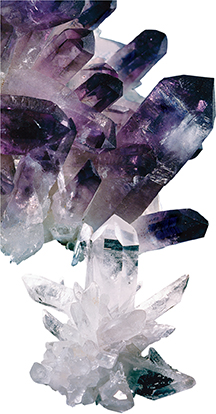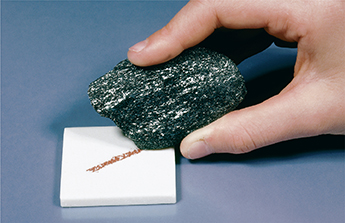The Properties of Minerals
Each mineral has a characteristic set of properties that results from its chemical composition and crystal structure.  The properties by which minerals can be identified include their crystal structure, color, streak, luster, density, hardness, fracture, and cleavage. The properties of many common minerals are summarized in Appendix D.
The properties by which minerals can be identified include their crystal structure, color, streak, luster, density, hardness, fracture, and cleavage. The properties of many common minerals are summarized in Appendix D.
Crystal Structure
In each type of mineral, the atoms are arranged in a particular geometric shape, or crystal structure. Each mineral always has the same crystal structure. However, the size of a mineral's crystals can vary. Some crystals are too small to be seen without a microscope. Others can be the size of telephone poles! Many crystals form long prisms with a specific number of sides. For example, quartz crystals, shown in Figure 9, have six sides. Other minerals have crystals shaped like cubes, sheets, needles, or threads. Halite, the mineral form of table salt, forms cubic crystals. Garnet, a red, semi-precious gem, often forms 12-sided crystals.
Figure 9 Quartz that is pure silicon dioxide is clear or white. Slight impurities produce a range of colors, including the violet quartz (amethyst) specimen shown here.

Color
Some minerals can be identified by a characteristic color. Pyrite, also known as fool's gold, is always golden in color. Crystals of pure sulfur are always yellow. But a mineral's color can often be deceptive, because slight changes in composition can cause significant changes in a mineral's color. For example, Figure 9 shows crystals of different colors, but they are all quartz.
Streak
The color of a mineral's powder is known as its streak. A mineral's streak can be found by scraping the mineral on a piece of unglazed porcelain called a streak plate. The color of a mineral's streak is not always the same as the color of the mineral itself. For example, the hematite shown in Figure 10 looks black or silvery, but has a red-brown streak.

What is a mineral's streak?
Figure 10 Although this piece of hematite is silver-gray, it can be identified by its red-brown streak.





